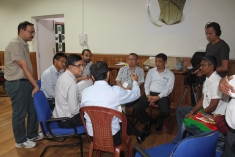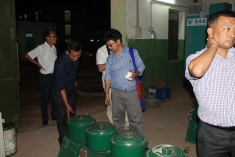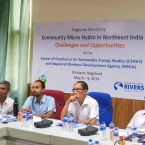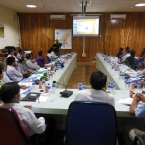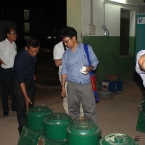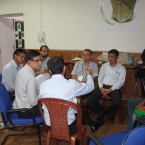The Power of Congregation
In May earlier this year, around 50 people gathered in the commercial capital of Nagaland to support and promote off-grid renewable hydropower solutions in the ‘seven sister states’ of India’s northeast region. This area is endowed with hundreds of perennial streams that can be diverted to run micro hydro turbines less than one megawatt each. These streams have the potential to provide truly renewable electricity to hundreds of remote and hillside communitites that remain unconnected to the power grid.
The gathering was co-organised by Nagaland Empowerment of People through Energy Development (NEPeD), a state government agency, with International Rivers. We at International Rivers have ramped up our work on finding sustainable energy solutions. In this capacity the South Asia Program along with Dipti Vaghela, the Energy Solutions Coordinator in Berkeley, California conceived this workshop, wherein for the first time officials from five state renewable energy departments, representatives from the Union Ministry of New and Renewable Energy, as well as academics and activists from the northeast gathered in the same room to discuss the potential development of small-scale hydro solutions. Veteran experts from Sri Lanka and Nepal's widely successful micro-hydro programs helped to facilitate the discussions.
The mantra of development in the northeast up until now has been ‘big is beautiful.' More than one hundred memorandums of understanding (MOUs) have been signed in the past decade between private companies and state governments to construct large hydropower projects in the region. The former Minister of State for Power in 2008, Jairam Ramesh, even referred to the signing spree as a “MOU virus.” But few projects have seen light of day. Some await statutory clearances while people are contesting projects on the grounds of forceful eviction and inadequate compensation. It is in this context that we believe off-grid decentralized solutions can engage and benefit the local community and improve the quality of life in the region.
As we went around the table introducing our work and giving voice to expected outcomes, it was clear that many participants were excited and had high expectations for the two-day workshop. The first day was split in two sections– the pre-lunch session provided an opportunity for micro hydro practitioners to share their achievements, failures and lessons from the field (although many were initially reluctant to do so). In the second half of the day, the entire group went on a field visit to see first-hand projects in development.
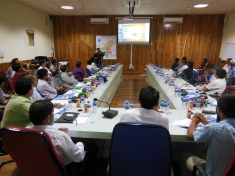
Leaving the seminar space we visited a 3 KW project site built by our partners NEPeD. The state agency stood out from the crowd of practitioners as they’re the only renewable energy department that manufactures their own 3 KW pico hydro turbines (projects with capacity under 5 KW are labeled as pico hydro). However, regardless of affiliation, all participants had experienced at one point or another bottlenecks in the planning process, failures and botched implementations to name a few. During the site visit, participants shared such experiences and difficulties through informal dialogue. Out in the open, everyone got useful insight in to the varying methods of the respective state renewable energy departments.
For instance, I spent a few days in Manipur – a neighboring state – prior to the workshop to study a 5 KW hydro project. The Manipur Renewable Energy Development Agency spent Rs 29 lakh (US$48,000) on the project. In comparison, a 3 KW project in Nagaland on average costs NEPeD less than Rs 3 lakh (or US$5,000). The discussions revealed that there is much variation in costs between regions and projects – mostly as a result of unnecessary or overdesigned civil constructions (weir, diversion channel, powerhouse etcetera) or dollars spent on beautification. Of course the turbine and site location also determine the total cost of project, but this alone cannot justify a ten-fold differential in cost.
Costs, best practices and technologies were discussed threadbare on the second day. Geek-speak on hertz, watts, voltage and frequencies existed alongside conversations among civil society representatives – many of who have been advocating against destructive large hydro projects in the region – during break out sessions for small-group discussion.
On the policy side, the Ministry of New and Renewable Energy gave a presentation on their new program to support small hydroelectric projects (less than 25 MW). Their role is restricted to setting guidelines and disbursing funds to state renewable energy departments in the form of subsidies. The new program will support projects up to 1 MW with Rs 6 lakh (US$10,000) to prepare detailed project reports. Thereafter special category states that require more assistance (such as those in the northeast) will be provided Rs 0.75 lakh (US$1,250) per kilowatt up to 1000 kw and Rs 7.5 crore (US$1.25 million) per MW limited to Rs 20 crore (US$ 3.33 million) per project up to 25 MW. International Rivers and our partners have long believed that subsidies should not be extended to projects beyond 1 MW, and that these projects, which are financially viable and have substantial impact on biodiversity and downstream flows, must be subjected to an environmental impact assessment. In addition, providing subsidies to projects larger than 1 MW benefits private developers as opposed to local communities. The Ministry officials made note of our critique.
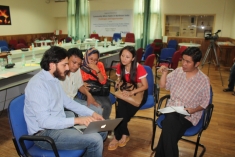
On the end of the second day, I held a briefing with a few journalists. The workshop was covered in the front page of all three regional dailies. We’re hopeful that the idea of renewable micro-hydro solutions is disseminated further and that our partners along with the other state renewable energy departments continue to see the postivie outcomes of the workshops into the future.
I recently heard from a NEPeD official expressing his grattitude, not only due to the great turnout and lively discussions at the workshop, but because of several potential orders for the turbines they are manufacturing in their facility since 2011. Suitable sites with adequate lean season flows have been selected. They are also about to sign a MOU with the Meghalaya Basin Development Authority, whose representative attended the workshop, to install sites across the border in the state of Meghalaya. There is a hope that local technology and knowledge will be shared, which will give NEPeD a boost in scaling up their manufacturing facility as well as quality control mechanisms.
The northeast of India is endowed with several perennial rivers, which according to government estimates have hydropower potential exceeding 50,000 MW. Many large dams are being planned and constructed bumper to bumper in river stretches without any clear assessment of the impacts these projects would cumulatively have on the river basin and the people living in downstream areas. Not to mention most of the projects will export energy to the ravenous northern and western parts of India with little benefit to the region itself.
Business as usual has not benefitted the people in these regions. A central goal of the workshop was to help inspire an evolution in which funding agencies, grassroots NGOs, and state governments work together and local suppliers, engineers, village youth and fabricators work in tandem with complete ownership over their projects. The next steps in the micro-hydro sector will be crucial to help turn the tide away from the exploitation of rivers and people and toward creating local benefits from the natural resources in the region.


